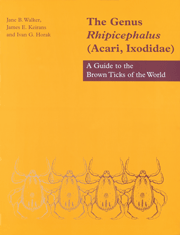Book contents
- Frontmatter
- Contents
- Acknowledgements
- 1 Introduction
- 2 Relationships of the ticks (Ixodida) and definition of the genus Rhipicephalus
- 3 Format for the accounts of individual species
- 4 Glossary
- 5 Rhipicephalus species names of the world
- 6 Rhipicephalus species occurring in the Afrotropical region
- 7 Accounts of individual species occurring in the Afrotropical region. pages 59 to 277
- Accounts of individual species occurring in the Afrotropical region. pages 278 to 490
- 8 Host/parasite list for the Afrotropical Rhipicephalus species
- 9 Rhipicephalus species occurring outside the Afrotropical region
- 10 Accounts of individual species occurring outside the Afrotropical region
- 11 Host/parasite list for the non-Afrotropical Rhipicephalus species
- 12 Species groups based on the immature stages
- 13 The transmission of tick-borne diseases of animals and humans by Rhipicephalus species
- Index
4 - Glossary
Published online by Cambridge University Press: 05 November 2011
- Frontmatter
- Contents
- Acknowledgements
- 1 Introduction
- 2 Relationships of the ticks (Ixodida) and definition of the genus Rhipicephalus
- 3 Format for the accounts of individual species
- 4 Glossary
- 5 Rhipicephalus species names of the world
- 6 Rhipicephalus species occurring in the Afrotropical region
- 7 Accounts of individual species occurring in the Afrotropical region. pages 59 to 277
- Accounts of individual species occurring in the Afrotropical region. pages 278 to 490
- 8 Host/parasite list for the Afrotropical Rhipicephalus species
- 9 Rhipicephalus species occurring outside the Afrotropical region
- 10 Accounts of individual species occurring outside the Afrotropical region
- 11 Host/parasite list for the non-Afrotropical Rhipicephalus species
- 12 Species groups based on the immature stages
- 13 The transmission of tick-borne diseases of animals and humans by Rhipicephalus species
- Index
Summary
Morphological features used in descriptions of Rhipicephalus spp. and taxonomic and other terms.
Accessory adanal plates Pair of small sclerotized tructures lateral to the adanal plates in males. May be present or absent. Also called accessory plates.
Adanal plates Ventral pair of large
sclerotized structures lateral to the anus in males.
Alloscutum The portion of the body wall in females and immatures posterior to the scutum that expands enormously to accomodate the large volume of blood ingested when these stages feed.
Anterior Towards the front end.
Anterior process Referring to anterior process on coxae I. When seen from the dorsal surface it is a sclerotized anterior projection of these coxae protruding in front of the scapulae as in R. appendiculatus.
Anus Posterior opening of the alimentary tract, situated ventrally and medially, posterior to the last pair of legs.
Article Distinct articulated portion of a jointed appendage.
Basal Closest to the origin or insertion.
Basis capituli Basal portion of the capitulum on which the mouthparts are attached; in the genus Rhipicephalus the basis capituli is hexagonal.
Bifid Deeply cleft, forming two
long spurs. (See coxa).
Capitulum Anterior movable portion of the body which includes the basis capituli, palps, hypostome and chelicerae. The tick's ‘head’.
Caudal process Distinct projection arising posteromedially from the median posterior end of engorged males of many Rhipicephalus species.
Central field Area on the conscutum or scutum between and delimited by the internal cervical margins.
Cervical fields Areas anteriorly on the
conscutum or scutum delimited by the internal and external cervical margins.
- Type
- Chapter
- Information
- The Genus Rhipicephalus (Acari, Ixodidae)A Guide to the Brown Ticks of the World, pp. 15 - 19Publisher: Cambridge University PressPrint publication year: 2000

